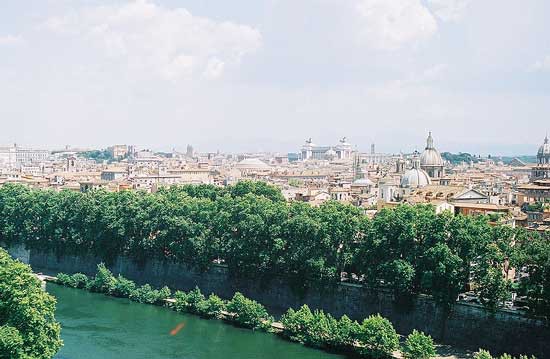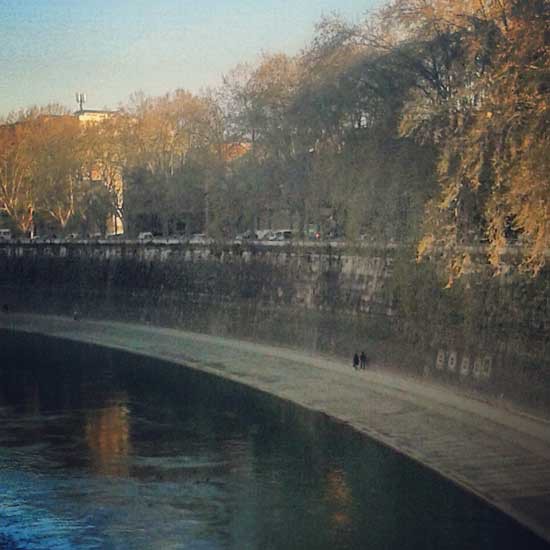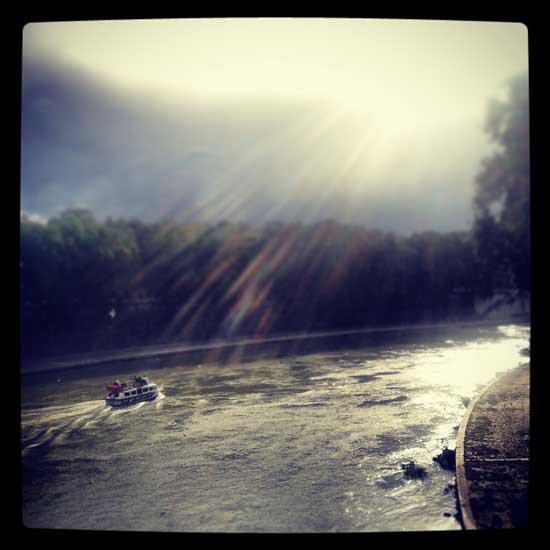Watercourses have always been a key element in the birth and historical development of civilization. Many are the empires had based their entire history on the presence of the water, for example Mesopotamia, the Indus Valley or Egypt. From trade to agriculture, from breeding to cultural value, rivers are an indispensable means for the survival of the peoples, to the extent acquiring even a symbolic meaning.

As is known, the city of Rome boasts the presence of an important river: the Tiber. This river originates on mount Fumaiolo, a highland located in the Apennines between Tuscany and Romagna, and flows into the Tyrrhenian Sea. After the Po and the Adige, the Tiber is the third Italian river in length; it runs for a total of about 400 kilometres between the Sabine Mountains and the Cimini Hills. Several tributaries and streams feed the Tiber along the way, among them the Aniene River, the Nera and the Farfa are certainly the best-known ones.
Owing to such wealth, we find it hard to believe that without the presence of this water supply, Rome would have had the same historical path. It was exactly around these areas of the region of Lazio that, during the eighth century BC, the first settlements arose.
According to traditional sources, the foundation of Rome dates back to 753 B.C., but the most substantial settlement traces are dated around the fourth century. B.C. and located in the city area of Ostiense. Throughout the first phase of Roman history, the city encourages a series of initiatives aiming at controlling the trades, and in such case, the river plays an essential role.
We know that Romans were experts in hydraulic engineering; it is they who at a later time, designed the aqueducts and even the so-called Cloaca Maxima, one of the oldest sewage systems known. We are only in the sixth century B.C., and all this is proof of this city’s ability to assimilate resources and knowledge from the civilizations and peoples with whom they came into contact, in order to give life to extraordinary initiatives, most notably the Cloaca, which was designed also on the basis of the contributions of knowledge drawn from the Etruscans.
As is easy to imagine, the river was important for businesses and for its connecting nature with the port area overlooking the Tyrrhenian Sea. The Romans called this river Tiberis, from which clearly derives the modern Tiber, but probably the oldest name is Rumon, from “ruminant”, which refers and emphasizes the erosion of the river banks that had perhaps been already noticed in ancient times.
Another expression with which the Romans indicated the Tiber is “Albula” or “Blond Flavius” due to the shades of the sand. A curiosity upon which is worth dwelling according to Servius, a Latin author who probably lived during the fifth century B.C., is that the city of Rome owns its name precisely to the Tiber. The terms Rumen or Rumon, used by Latins to identify the river, share a similar root to Rome, and more specifically to the verb Ruo, or “flow”.

As regards to the legendary sources on the origins of Rome, we learn that it was Aeneas, the famous mythological hero, fugitive from Troy and in search of a homeland, to arrive in the area where Rome would have been founded, and here too the river plays an essential role. Aeneas, going up the mouth of the river, which at the time was known as Albula, arrived in an area inhabited by shepherds. The river was later named Tiber, probably in honour of a river god or a king called Tiberinus, who may have had some connection with the waterway.
Legend or not, we know that the river was exploited right from the city’s origins and that the population undertook a series of interventions in order to optimally utilize this reserve. The Tiber was used as a source for drinking water, as a connection and communication route, navigable by boats, and as a favourable environment for fishing. Wooden bridges were constructed to cross the banks, buildings that later became masonry. As mentioned already, the first aqueduct of Rome owes its origins to Appius Claudius, who also built the famous Via Appia.
Today, the Tiber is a wonderful waterway that runs through the Eternal City, offering its visitors views that are difficult to forget. Just outside Rome, besides the GRA, the Grande Raccordo Anulare (Great Ring Junction), the river runs within a protected area that is part of the Natural Reserve of the Roman Coast. Throughout its course, the river encounters several different species of plants, shrubs, trees such as poplars, eucalyptus, pines and various wildlife species which find here an ideal habitat. We know, in fact, that at the time of the reclaim, for logistical reasons, a series of shrub species capable of absorbing excess water were planted in the area of the estuary. This is the reason for the extraordinary biodiversity that characterizes the Roman landscape today.



